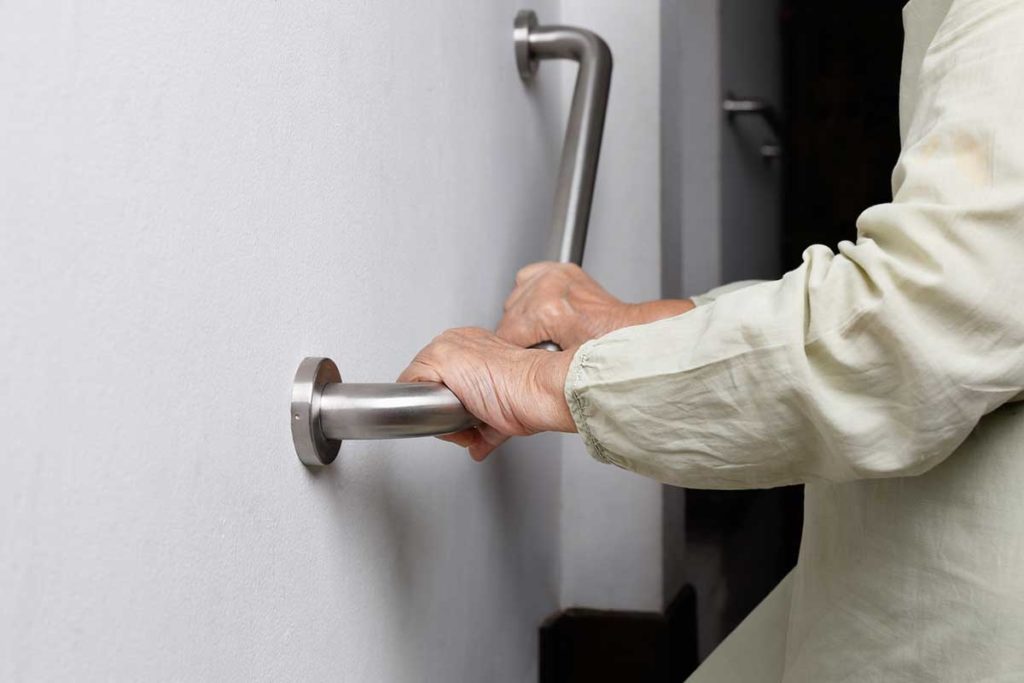
The best option is to set up everything the way you need it before you need it that way. If you plan to age in place, now is the time to make the changes you’ll need. That way you won’t have to worry about the future or ponder what you’ll have to do to make your living room livable, safe, and secure.
The best option is to set up everything the way you need it before you need it that way.
You Need Room to Move Around
Simple space—enough room to navigate, and enough room to get to everything you need to access—makes the difference between a livable living room and one you’ll have to avoid as you get older. If you become disabled, for example, you may struggle with simple tasks such as getting from one room to the other, or getting through your living room to use the bathroom, go to the kitchen, or even answer the door if someone comes to see you. In short, your living room needs to be big enough. There are two ways to accomplish that, and which way you choose will depend on the current size of the living room you already have.
If you have a space that’s tiny, you may need to add onto your home. You may also be able to use additional space from another room. If you have an unused bedroom or a dining room that you aren’t spending any time in, for example, you can take space from these areas to get a larger living room. It may be costly to take out some walls, but that’s a far less expensive process than adding extra square footage to your home’s footprint.
Of course, the problem isn’t always the amount of space. Sometimes there’s just too much in it. Especially if you’ve lived in your home for years, you may have more things filling your living room than you need there. Getting rid of all of them may not be realistic: after all, the living room is the place to display objects with sentimental value. But rearranging things isn’t the same as getting rid of them. If your living room is cluttered, you can free up some much-needed space by moving some items to other rooms or even by giving them to friends and family members who will appreciate them.
Ideally, you should be able to move about freely in your living room, and that should be true even if you have mobility issues later on. A cane, crutches, a walker, or even a wheelchair should all have adequate room. You’ll also want to consider whether a wheelchair can turn around in the space, because getting it into a location isn’t the same as getting it out. By taking the time to establish the best size and layout for the living room, you’ll be prepared for any eventuality that may come along as you age in place.
According to the National Association of Home Builders, a five-foot by five-foot clear space in the middle of the living room is a good idea. That leaves enough room to navigate a wheelchair and get turned around properly with a walker—an essential, since backing up with a walker can quickly become a fall hazard. Again, aging in place requires addressing such issues now, since things can change quickly as a person ages. With that in mind, it’s much better to clear that space and have it already open, so you don’t have to worry about creating it when you need it later.
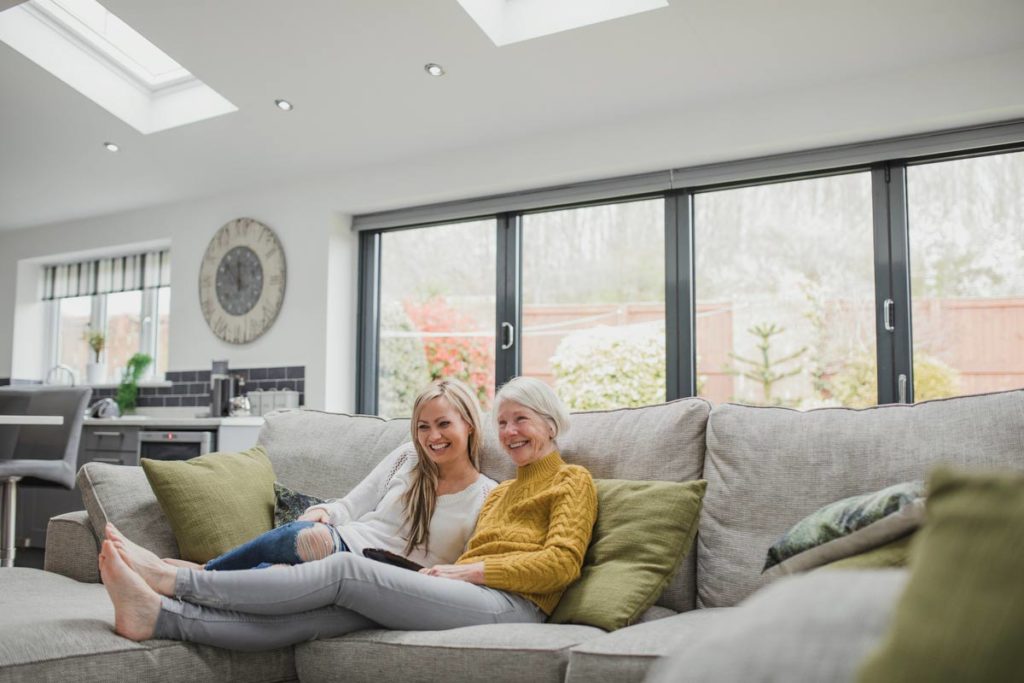
The Layout Matters
As you age in place, you’ll want to consider more than just the size of your living room space. Of course you need enough room and a space that’s uncluttered, but how you lay out that space also affects whether you can safely get around. A coffee table with legs that curve outward, for example, can be a tripping hazard. An end table that’s too far from the side of the couch can mean that you can’t reach what’s there and without risking a fall or strain as you lean over. There are all kinds of problems that can occur from a bad layout.
There’s no need to get rid of every piece of furniture: keep everything you need, but keep only those things, so your layout remains simple and efficient. If you need to use a wheelchair later and you want to transfer from the chair to the couch, is the coffee table in the way? Does the couch slide on your wood floors? These are the kinds of questions to ask yourself when you’re setting up your living room to age in place. You can still make your living room look nice, but the main goals need to be comfort and safety.
Many people worry they’ll need to take almost everything out of the living room so they can have space, and they forget that they also have to live there. Especially if you have other people who live with you, or if you plan to have a lot of visitors, you want to make sure you can still offer places to sit and be comfortable. It may be necessary to try several different layouts in order to get the one you like the best, because not all of them are going to be created equal when it comes to the space you have to work with.
As you set up your living room to age in place, don’t just say—at random—”that chair goes in the corner and this sofa goes against the wall.” Instead, try several different options until you decide on one that’s right for you. That will make it easier to get ahead of the aging process in a way that preserves the most important parts of your decor and sense of style but still ensures your comfort and safety. The bottom line is that the layout is nearly as important as the actual size of the space, because there are ways to make even smaller spaces safer and easier to navigate.
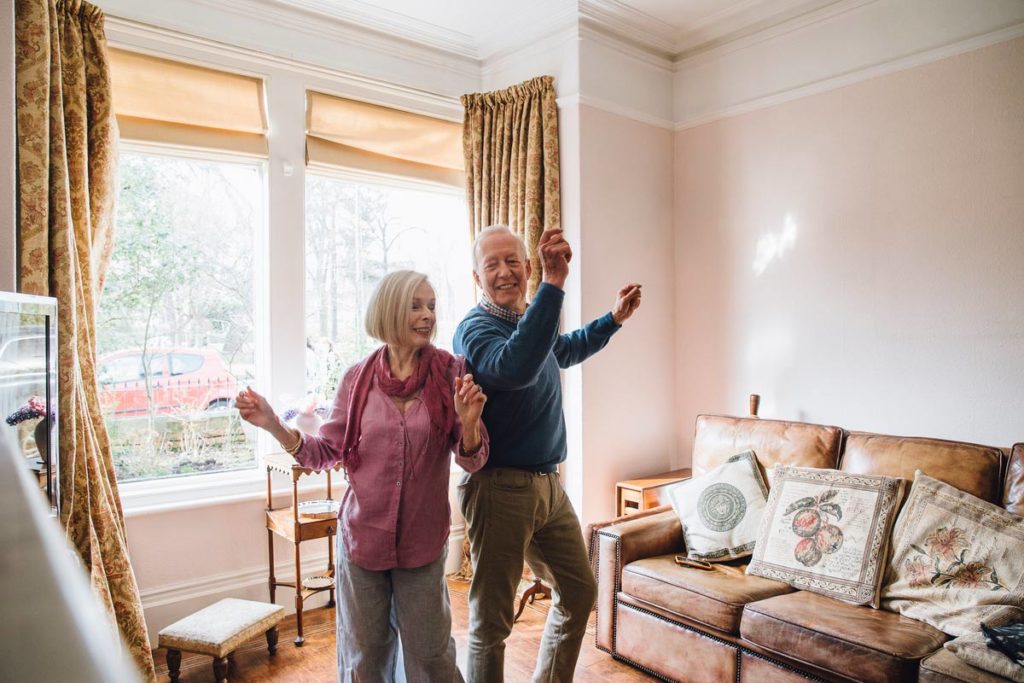
Electronics and Remotes May Need to be Changed
With today’s electronics, getting acquainted with a new remote can feel like an impossible task, but that small TV and the remote with 70 buttons may not work for you as you age. Additionally, if you have a number of remotes for different things, that could make life difficult as well. You’ll want to avoid that, and there are choices you can make now that will help you later on. Just remember that technology changes fast, so you may not want to change your electronics and remotes now if you’re still on the younger side, since new technologies may emerge (voice commands, for example) before you need to make any choices.
A 2017 survey revealed that almost one-third of seniors have no emergency savings and 70 percent have less than six months of savings
For people who are already aging in place or are getting close to that time in their life, though, changing the electronics and remotes they use simply makes sense. You can buy remotes that have larger buttons and that are simplified, so you have fewer things to press and it’s harder to make a mistake that may leave you stuck on a TV channel you don’t want to watch or wondering why your DVD won’t play like it’s supposed to. Think carefully about the level of TV watching you do, and the types of things that are most important to you, and then focus on a remote and electronics that can give you those options.
Those are really all you need on a daily basis, and the chances are high you can get some extra help if you need it for a special occasion or something you wouldn’t normally do or view. The size of your TV can matter as you age, as well. You may not be able to see as well, and an HDTV in a larger size can help you see the screen better and can provide you with a sharper, clearer picture to watch. That makes a big difference for many elderly people who enjoy watching TV and want to be able to see their favorite programs without feeling like they’re missing out. Closed captioning can also help for those who are hard of hearing.
If you can find a TV that’s as big as you can reasonably afford and have in your space, the odds are you won’t need a different one later on unless that one actually quits working. You’ll also want to take a look at what types of universal remotes are available, and look for a balance between a simplified design with larger buttons and enough functionality for what you need. Getting a remote that does all the basics you need easily can be a good choice for everyday use, while the more complicated remotes can be stored away close by for times when they may be needed for something you wouldn’t always need or use.
Consider Putting Grab Bars in Your Living Room
One of the ways you can make things safer for yourself as you age in place is to put grab bars in your living room. These can be in two different types of locations: beside where you would normally sit so you can get up more easily, and along walls so you can use them to steady yourself as you walk to the kitchen, bathroom, bedroom, or other locations. Both are good options, just depending on the level of need you have. Since that need may change with time, it’s worth considering putting the bars in even if you don’t need them right now. It’s much better to have them and not need them than the other way around.
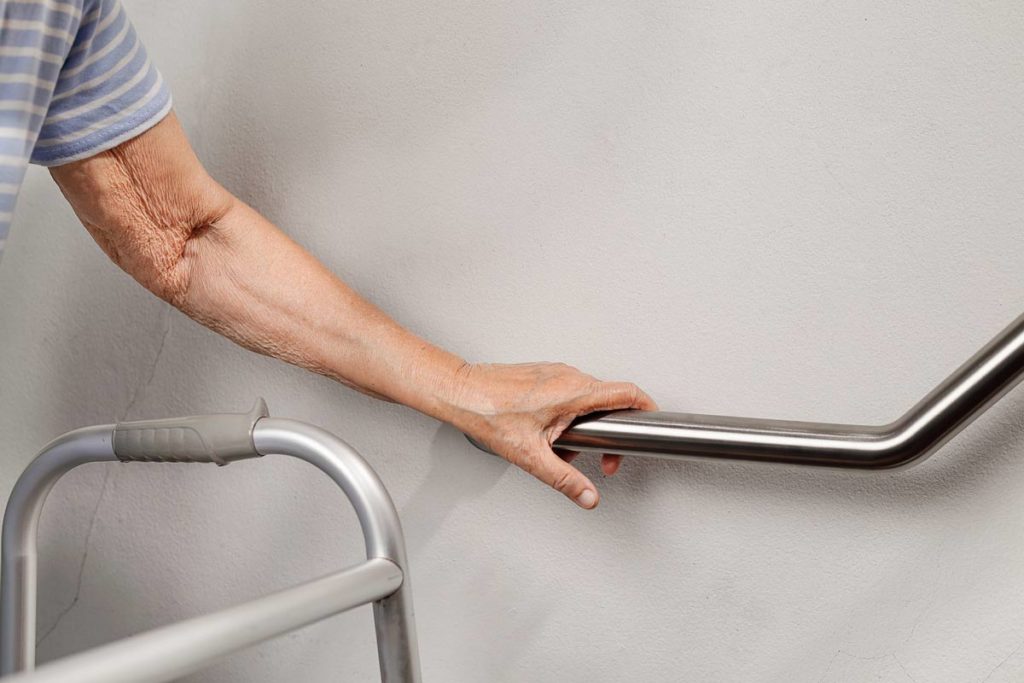
Grab bars are generally metal, and look like stainless steel, but there are other options for colors, styles, and looks. You don’t have to turn your living room into something that looks like an industrial site just for safety’s sake. You can find grab bars that fit your esthetic better, and that look more like what you would have in an elegant space. These look more like railings, and they can stand out or blend in, depending on what you like. But the most important thing is that they are placed correctly and work well, so you can have the level of protection you need and want as you age in place over time.
Even the best grab bars aren’t going to blend in completely, and putting up too many of them may change the look of the room. But it’s important to remember that safety needs to come before looks, in every room of the house. Additionally, having the grab bars may come in very handy later on, and they will already be in place if they’re ever needed. In time they’ll simply become part of the furniture, and you won’t really notice them. But if you ever struggle to get up from your furniture or you need some extra stability when walking along by the wall, the grab bars will be there to help support and protect you.
So, What About the Furniture?
The layout of your furniture matters, but that’s not the only consideration. You also have to think about the kind of furniture in your home. That old recliner you have may be comfortable, but getting up out of it may get more difficult as time goes by. The same could be true for a favorite couch where you spend a lot of your time sitting. No matter what kind of furniture you have in your house right now, aging in place demands that you look ahead. Comfort matters, of course, but safety has to take priority. That could mean new furniture, and there are a lot of options for furniture that can help you be safe.
No matter what kind of furniture you have in your house right now, aging in place demands that you look ahead.
Recliners that adjust and lift you all the way to a near-standing position are available, and many of them are very affordable. There are also couches that recline and that provide you with some extra lift, along with other types of chairs that will protect you and reduce your risk of falling and getting hurt. No matter what you decide to do with the furniture you have, there should be at least one place you can sit where you know you’re safe from falling and can get back up again. Most people choose a recliner that will also help them stand, but considering all your options is the best way to make an informed decision.
Furniture that’s purchased for aging in place may look a bit different from furniture that’s purchased specifically for comfort or style. That doesn’t mean the furniture can’t be comfortable, though. There are plenty of furniture options that look and feel good, and that also offer extra assistance for people who may have trouble getting into and out of chairs, or up and down from a couch or loveseat. You’ll find some of this furniture at local stores, and some you can shop for and purchase online, where pieces can be shipped to your home and delivered inside to be placed wherever you want and need them.
Your Flooring Shouldn’t Be a Hazard
Flooring really matters when it comes to protecting people as they age in place, and there are two points of view about the kind of flooring you should use. On one hand, there are people who recommend carpet because it’s softer and there is less of a chance that someone falling on it would get a broken bone or other injuries. On the other hand, there are people who believe that hard flooring is the right choice because it’s easy to clean and less of a tripping hazard. Both arguments have merit, but as you make your choice, remember: the goal is not to make the floor soft for falls. It is, instead, to prevent falls in the first place.
Choosing carpet means a softer landing if someone does fall, of course, but a shaggy carpet also makes a fall more likely. Rather than take that risk, choose a low-pile carpet if you decide that harder flooring isn’t for you. At the end of the day it’s your house, and you have the right to age in place in the way you feel the most comfortable. If you strongly prefer carpet, choose carpet that still provides a relatively firm surface. That means a low pile and a thinner pad, but it’s generally worth those trade-offs to get a no-trip surface under your feet.
The lower pile will be easier to navigate a walker or wheelchair over, and if you have an injury or disability later, a low pile is less likely to catch your feet and cause you to trip. The thinner pad will make the carpet a firmer surface to move along, which also reduces the chance of falling and makes it easier to move a walking aid or wheelchair across it. While it may not be an issue at the moment, changes that take place as you age could affect how easily you move around your living room. Carpet that is firmly in place, low in pile, and free of any kind of wrinkles or a high level of flexibility will be much safer in the long run, reducing your chances of getting injured.
If you choose hard flooring you’ll need to keep in mind that falling on it can be more of a risk for injury. But the value in harder flooring is that it’s less of a tripping hazard. Additionally, it’s easier to keep clean and makes it easy to move a wheelchair or walker across through the space. That can make a big difference in how easily you get around your living room. Just be aware that hard floors often mean area rugs, and those can definitely be a problem and a tripping hazard if they aren’t properly anchored down.
You Need Quick and Easy Access to a Phone
Getting to a phone fast is vital in an emergency, and can be important even when there’s no crisis at hand. But if age or the disabilities or challenges that go with age limit your mobility, you may not be able to just get up and get the phone if you need to unless it’s been placed in the room with some care. And yet you need to be able to access a phone quickly and easily no matter where you are. Having a cell phone that fits in your pocket or clips to your hip is one of the ways you can reduce the risk of not having a phone available to you, but it’s not the only option. There are other choices.
There are some phone systems available that offer a voice command function, which can protect you if you can’t reach the phone and still need to use it.
One of those choices is to have a phone with multiple handsets. Some cordless phones do come this way, and it’s also possible to get several corded phones and have one in each room. Having a phone in every room, however, doesn’t necessarily mean you’ll be able to reach it when you need it the most. If you’re on the other side of the room or you simply can’t reach the phone from where you are, or if you’ve fallen or otherwise can’t get to the phone, having it in the room isn’t really relevant or helpful. That’s worth considering when it comes to where to place any phones you have.
There are some phone systems available that offer a voice command function, which can protect you if you can’t reach the phone and still need to use it. These phones naturally cost more and require more technological savvy to install than more standard models, but they can be well worth the cost if they help protect you in your home as you age in place. Having an opportunity to answer the phone or call someone if there is a problem could make the difference between getting help when needed and being unable to reach out to paramedics, family, or even a neighbor for assistance.
There are pendants and other methods that can be used to reach out to emergency help, as well, but those are only designed to alert the monitoring company that provides the pendant or other technology. They can work very well in a serious emergency, but they aren’t as good of a choice for minor issues where a neighbor or a family member could come over and help correct a problem. All that’s needed during a time like that is a little extra help, not emergency responders, so the majority of the time, all you need is simply to be able to access the phone.

Think About Lighting
One big risk for elderly people who age in place is being able to see well enough to navigate around furniture and other obstacles. If the lighting in your living room is poor, you have a higher risk of tripping over something or getting hurt in some other way. For the most part, however, changing the lighting shouldn’t be that difficult. The biggest challenge may be improving your overhead lighting, since being able to turn the lights on and see everything easily is vital for avoiding accidents. If you don’t already have one, you may want a switch near the door and one closer to where you sit, so you can have good lighting as you walk through the room and then turn the lights back off without getting up. You may also need to boost the wattage in your overhead fixtures, which will probably require the help of a professional.
Additionally, you can have extra light by using table lamps. It’s very important that these lamps aren’t easily breakable if they get knocked over, and that the cords are run in such a way that you aren’t at risk of tripping over them. It would be better to have fewer lamps than have cords in areas where you might walk or use a wheelchair. In order to set up the living room the right way and have table lamps where you need them, you may need to move or add an electrical outlet. That can cost money and require some sheetrock repair, but it’s generally worth doing to ensure you have good lighting in your home.
The kind of lighting you have matters, as well. You can choose energy efficient bulbs that mimic daylight, and these can help your mood as well as make it easier to see. With these types of bulbs, the extra lighting will actually be easier on your electric bill as well. Cost is something to consider when buying light bulbs, but the quality of light and how long the bulbs will last are more important issues. Keeping this is mind, it’s important to look for lamps that take the size and wattage of bulb you’re interested in. Very low wattage bulbs aren’t going to give you the kind of lighting you need to be safe and secure.
Will You Eat, Sleep, or Perform Other Functions in Your Living Room?
If you plan to eat in front of the TV or sleep in your recliner, or if you at least want the option to do those things, you’ll need to make sure your living room is set up to do that. There are TV trays that clip to chair arms, and plenty of warm blankets and pillows that can keep you comfortable in a recliner or on the couch. You’ll need somewhere to store those things, too, so you should incorporate a blanket chest or other way of putting away the things you’ll want in the living room into your design. Not everyone will want these things, but it’s important to be aware of what you may encounter as you age, and prepare as much as possible.
A lot of elderly people like to eat in the living room so they can watch TV. Some of them may have health conditions or chronic pain that makes it easier to sleep in a recliner. While you may or may not have any issues with those things right now, you may feel differently at a later date. Because of that, it’s good to plan for as many eventualities as possible. Then you can be ready when things change as you age, and you’ll be much more likely to be able to age in place without a struggling to change things after a problem arises. It’s not possible to plan for everything, but there’s no reason not to try for a high level of preparation.
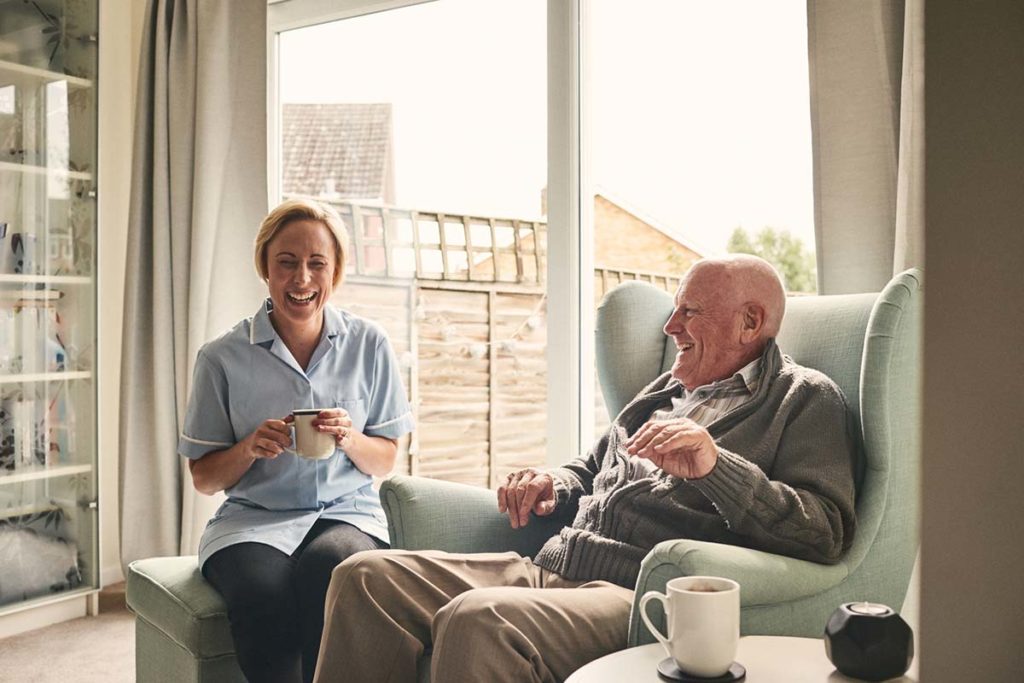
Staying Warm Enough or Cool Enough
Being comfortable in your space is very important, and as you age it can be more difficult to regulate your temperature correctly. That’s why it’s so important to give some thought to heating and cooling. Depending on the age of your house and the area of the country you live in, you may not have whole-house heating or air conditioning. Many homes in the Pacific Northwest, for example, don’t have air conditioning at all. They use window a/c units or just fans in the summertime, mostly because there are very few days where it’s hot enough to need anything more than that.
Electric heaters and small electric fireplaces are often good choices, because they are solid and stationary. They can’t get knocked over easily, so the risk of fire or other problems is extremely minimal.
But for areas of the country where it gets very hot in the summer, a whole-house air conditioner may be a necessity. If you don’t have one, the price of putting one in may be beyond your budget. But there are ductless options that can be used instead. These allow for cooling in one or more rooms, but don’t always include the entire house. You can have one put in your living room, so you can stay cool in the summer and be more comfortable as you age in place. The same is true with heat, where you can have smaller heaters in your living room even if you don’t have a whole-house furnace or other option.
Electric heaters and small electric fireplaces are often good choices, because they are solid and stationary. They can’t get knocked over easily, so the risk of fire or other problems is extremely minimal. There isn’t any flame to worry about, and they are sealed units that don’t get hot enough to burn someone. For extra heating in one or more rooms, choices like this can be ideal. Your living room will be cozier and warmer in the winter, cooler and more comfortable in the summer, and safe and secure all year round, which will give you the best of all worlds.
What Do You Like to Do All Day?
As you age, your hobbies may change some, but for the most part you’ll probably want to do many of the same hobbies you do right now. Consider which hobbies you might pursue in the living room, and whether you can still do them with the other changes you’re making. If you can’t get around the same way you do now, if you need a walker or wheelchair to get around, or you otherwise have challenges that naturally come with aging, how can you adjust your hobbies and your living room so they work well together? The more you make those changes now, the easier it will be for you later, when you want to pursue those hobbies in your later years.
Some hobbies can be done just about anywhere, but having them closer to you in the living room can make things easier and more enjoyable. If you read, for example, include bookshelves in your living room design. If you like to knit or crochet, having a basket of yarn and other supplies next to your favorite spot on the couch is a good idea. You may need different types of storage to do those things, however, and putting that storage in place could take time. Experiment now to find options that will work for you, so you’ll have the best plan in place as things change.

Make Your Living Room Easy to Clean
Being able to clean your living room is probably important to you, and the odds are high that it will stay important to you in the future. With that in mind, you’ll want a living room that’s easy to clean and take care of. Hard floors can help with that, as can a vacuum system like a Roomba that cleans for you. You may also want vertical blinds instead of horizontal blinds or curtains because they collect less dust, and couches and chairs that are made of fabrics that don’t stain easily. There are plenty of options to make cleaning easier, and when you consider them for your home as you age in place, you plan ahead for comfort and security.
Overall, there are many options for keeping things cleaner. For example, if you put your knickknacks in a glass-front cabinet, you can still enjoy the way they look without having to worry about dusting them. After all, the point of aging in place is not to pare down the things you have until your home doesn’t feel like yours anymore. Instead, the goal is to make sure you’ll be safe and secure in your home while still keeping it as much like the home you remember as possible. That takes work and ingenuity, but it is worthwhile in the long run because it can keep you in your beloved home for many more years.
Do you want to cite this page? Use our ready-made cite template.